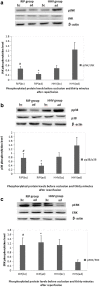Regional Ischemic Preconditioning Has Clinical Value in Cirrhotic HCC Through MAPK Pathways
- PMID: 30542823
- PMCID: PMC6702190
- DOI: 10.1007/s11605-018-3960-1
Regional Ischemic Preconditioning Has Clinical Value in Cirrhotic HCC Through MAPK Pathways
Abstract
Background: This study assessed the clinical value of regional ischemic preconditioning (RIP) and the role of the mitogen-activated protein kinase (MAPK) pathways in the protective mechanism of RIP in cirrhotic hepatocellular carcinoma (HCC) patients undergoing hepatectomy.
Methods: Liver resection was performed with hemi-hepatic vascular inflow occlusion (HHV) under RIP (RIP group) or with HHV alone (HHV group). Clinical data, surgical outcomes, and the levels of phosphorylated MAPKs before occlusion and 30 min after reperfusion were estimated.
Results: HHV under RIP was associated with less intraoperative blood loss (300 vs. 400 ml; P = 0.042), postoperative plasma transfused (400 vs. 800 ml; P = 0.019), and a higher level of prothrombin activity at postoperative days 3, 5, and 7 compared to HHV alone. The level of phosphorylated ERK protein was significantly increased and the levels of phosphorylated p38 and JNK proteins were significantly decreased 30 min after reperfusion compared to HHV group in the RIP group.
Conclusions: HHV under RIP may have clinical value in cirrhotic HCC patients requiring resection and the protective mechanism of RIP may be associated with changes in the protein phosphorylation level of MAPK pathways.
Keywords: Cirrhosis; Hepatocellular carcinoma; Mitogen-activated protein kinase; Regional ischemic preconditioning.
Conflict of interest statement
The authors declare that they have no conflict of interest.
Figures




Similar articles
-
[Initial comparison of regional ischemic preconditioning and hemi-hepatic vascular inflow occlusion in resection of hepatocellular carcinoma].Zhonghua Zhong Liu Za Zhi. 2015 Mar;37(3):186-9. Zhonghua Zhong Liu Za Zhi. 2015. PMID: 25975786 Clinical Trial. Chinese.
-
Ischemic preconditioning protects liver from hepatectomy under hepatic inflow occlusion for hepatocellular carcinoma patients with cirrhosis.World J Gastroenterol. 2004 Sep 1;10(17):2580-4. doi: 10.3748/wjg.v10.i17.2580. World J Gastroenterol. 2004. PMID: 15300911 Free PMC article. Clinical Trial.
-
A prospective randomized controlled trial to compare pringle manoeuvre with hemi-hepatic vascular inflow occlusion in liver resection for hepatocellular carcinoma with cirrhosis.J Gastrointest Surg. 2013 Aug;17(8):1414-21. doi: 10.1007/s11605-013-2236-z. Epub 2013 May 29. J Gastrointest Surg. 2013. PMID: 23715650 Clinical Trial.
-
Research toward safer resection of the cirrhotic liver.HPB Surg. 2000;11(5):285-97. doi: 10.1155/2000/31945. HPB Surg. 2000. PMID: 10674743 Free PMC article. Review.
-
Current concepts in hepatic resection for hepatocellular carcinoma in cirrhotic patients.World J Gastroenterol. 2012 Nov 28;18(44):6398-408. doi: 10.3748/wjg.v18.i44.6398. World J Gastroenterol. 2012. PMID: 23197885 Free PMC article. Review.
Cited by
-
Enhanced recovery after surgery strategy for cirrhosis patients undergoing hepatectomy: experience in a single research center.Ann Surg Treat Res. 2020 May;98(5):224-234. doi: 10.4174/astr.2020.98.5.224. Epub 2020 Apr 28. Ann Surg Treat Res. 2020. PMID: 32411627 Free PMC article.
-
Impact of Neoadjuvant Therapy on Minimally Invasive Surgical Outcomes in Advanced Gastric Cancer: An International Propensity Score-Matched Study.Ann Surg Oncol. 2021 Mar;28(3):1428-1436. doi: 10.1245/s10434-020-09070-9. Epub 2020 Aug 29. Ann Surg Oncol. 2021. PMID: 32862371
-
Clinical Significance of TUBGCP4 Expression in Hepatocellular Carcinoma.Anal Cell Pathol (Amst). 2022 Dec 8;2022:9307468. doi: 10.1155/2022/9307468. eCollection 2022. Anal Cell Pathol (Amst). 2022. PMID: 36530949 Free PMC article.
References
-
- Isozaki H, Okajima K, Kobayashi M, et al. Experimental study of liver injury after partial hepatectomy with intermittent or continuous hepatic vascular occlusion. Differences in tolerance to ischemia between normal and cirrhotic livers. Eur Surg Res. 1995;27(5):313–322. doi: 10.1159/000129415. - DOI - PubMed
-
- Makuuchi M, Mori T, Gunven P, et al. Safety of hemihepatic vascular occlusion during resection of the liver. Surg Gynecol Obstet. 1987;164(2):155–158. - PubMed
Publication types
MeSH terms
Substances
LinkOut - more resources
Full Text Sources
Medical
Research Materials
Miscellaneous

